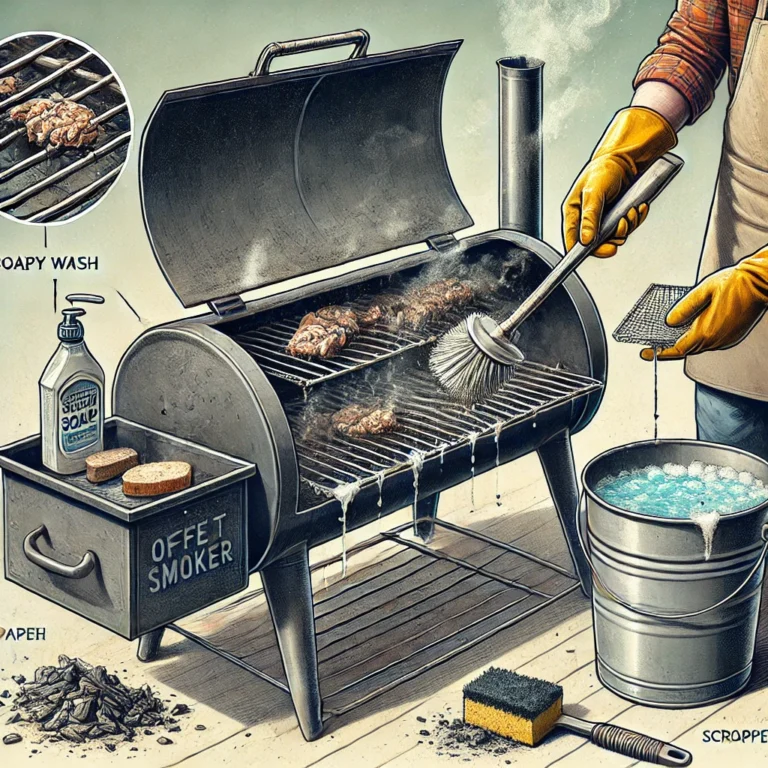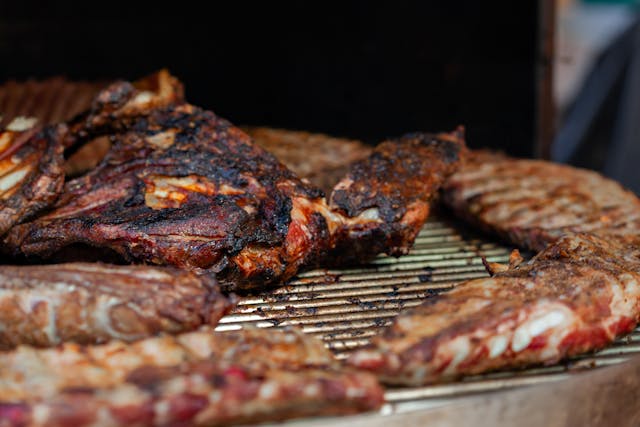7 Essential Steps for Seasoning Your Offset Smoker Perfectly.
Seasoning your offset smoker is a crucial first step before you begin cooking. This process not only protects your smoker from rust but also helps to remove any chemicals, oils, or residues left over from the manufacturing process. A well-seasoned smoker will last longer, perform better, and contribute to better-tasting barbecue. In this guide, we’ll take you through the steps of how to season your offset smoker properly.

Seasoning essentially creates a protective layer of oil and smoke inside your smoker, which prevents corrosion and helps with heat retention. Much like seasoning a cast iron skillet, this process involves coating the smoker’s interior surfaces with oil and heating it to high temperatures. Over time, this protective layer will enhance the smoker’s performance, resulting in more even cooking and better smoke flavor. Before you get started, it’s important to know that seasoning a smoker is not a one-time task. For best results, you should season your smoker at least once a year or more frequently if you use it often.
1. Why You Need to Seasoning Your offset Smoker
Seasoning your smoker is an essential step that enhances both the longevity and performance of your equipment. Without seasoning, your smoker is vulnerable to rust, which can develop quickly, especially if the smoker is exposed to moisture. The protective oil layer created during seasoning acts as a shield, reducing the risk of rust formation. Moreover, the manufacturing process often leaves behind chemicals, oils, or debris that, if not removed, can interfere with the flavor of your barbecue and be potentially harmful when exposed to heat. Seasoning burns off these residues, leaving your smoker clean and ready for use.
- Enhanced flavor: Seasoning helps lock in flavors and prevents food from tasting like metal or picking up residues.
- Longevity: Regular seasoning prevents rust and extends the smoker’s life.
- Improved cooking surface: The oiled surface also makes it easier to clean after cooking, as food is less likely to stick.
2. Gathering Supplies for Seasoning Your Offset Smoker
The seasoning process requires only a few key supplies, but choosing the right materials is important for achieving the best results. High-temperature oils, like vegetable or grapeseed oil, work best because they can withstand the heat needed for seasoning without burning. You’ll also need charcoal and wood to generate the heat inside your smoker. Finally, a spray bottle or cloth will help you apply the oil evenly across the smoker’s interior surfaces.
- High smoke-point oils: Using the right oil ensures that it bonds with the metal properly without smoking too much or burning.
- Charcoal and wood selection: Opt for lump charcoal or hardwood chunks for a steady burn and even heat distribution.
- Spray bottle or cloth: A spray bottle makes applying oil quick and even, ensuring all surfaces are coated.

3. Seasoning Your Offset Smoker Before Cleaning
Cleaning your smoker before seasoning is critical to remove any dust, dirt, or debris from the manufacturing process or storage. This step ensures that the oil bonds directly to the metal surface, providing an even and effective seasoning. Start by removing any packing materials, such as plastic wrap or cardboard, and give the smoker a thorough wipe-down.
- Mild detergent and water: Use mild soap and water to clean the inside and outside of the smoker.
- Scrubbing stubborn spots: If you notice any grease or manufacturing oils, use a brush to scrub them off.
- Dry thoroughly: After cleaning, make sure the smoker is completely dry before applying oil. Any moisture trapped inside can lead to rust during the seasoning process.

4. Applying Oil to the Interior
Once your smoker is clean and dry, the next crucial step is applying oil to the interior. The oil acts as a seasoning agent, bonding with the metal surfaces to form a protective layer. This layer not only guards against rust but also enhances the smoker’s heat retention and flavor absorption properties. To apply the oil, either spray or use a cloth to coat all surfaces inside the cooking chamber and firebox, including the grates, walls, and lid.
- How to apply: Use a spray bottle or cloth to evenly coat all surfaces inside the smoker, including the firebox and cooking grates.
- Don’t oversaturate: Avoid using too much oil, as it can drip and cause flare-ups during the seasoning process.
5. Start the Fire and Heat the Smoker
Now that your smoker is prepped, it’s time to light the fire. Use charcoal or wood as your heat source, depending on your preference. If you’re using charcoal, a chimney starter can help you get the fire going quickly. Place the lit charcoal in the firebox and allow the smoker to gradually heat up. The goal is to maintain a temperature of 250°F to 300°F for about 2 to 4 hours. This heat will not only burn off any lingering chemicals but will also help the oil bond with the metal, creating that essential protective layer.
6. Maintain the Heat for an Even Coating
During the seasoning process, it’s important to monitor the temperature and maintain a consistent heat. Check the temperature gauge on the smoker frequently, adding more charcoal or wood as necessary to keep the heat steady. You should also open the smoker’s vents to allow for proper airflow. This helps the fire burn cleanly and prevents the buildup of soot inside the smoker. By keeping the heat consistent, you’ll ensure that the oil is evenly distributed and properly bonded to the metal.

7. Cool Down and Inspect
After the smoker has been heated for several hours, allow it to cool down slowly. Don’t open the smoker door or the firebox immediately, as this can cause a rapid temperature drop, potentially cracking the metal. Final check Inspect the smoker for any spots that didn’t get properly coated. Reapply as needed If some areas look dry, apply a light coat of oil and repeat the heating process.
Conclusion
Seasoning an offset smoker is a crucial step that not only extends the life of your smoker but also improves the flavor of your food. The process of applying oil and heating the smoker creates a protective barrier against rust, eliminates any harmful chemicals, and sets the stage for the smoky, delicious flavor that barbecue enthusiasts love. By taking the time to properly season your smoker, you’re investing in long-term performance and better cooking results.
seasoning your offset smoker is a crucial step to ensure optimal performance and flavor. By following these 7 essential steps, you’ll not only prepare your smoker for a longer lifespan but also enhance the taste of your food. Whether you’re a seasoned pro or a beginner, taking the time to properly season your smoker will result in a more consistent cooking experience and delicious smoked dishes. So, fire up that smoker, follow the steps, and get ready to enjoy perfectly smoked meats every time!







